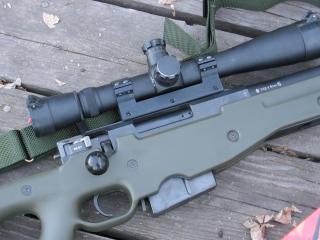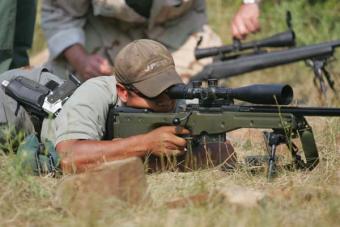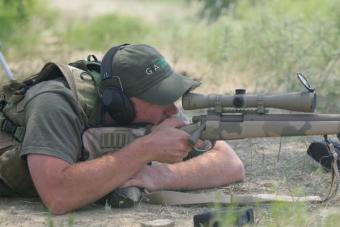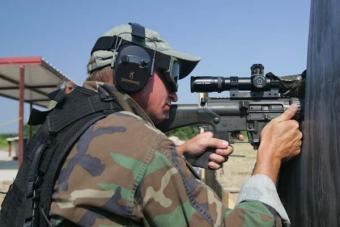
 Leupold 3.5-10x40mm M1 scope with 1/4 MOA-click external knobs, mounted on an Accuracy International (AI) AWP
Elevation Travel
The scope's internal mechanical design and the scope mounts used determine the maximum range for
which elevation can be specified. In the specifications for a scope, the maximum elevation
travel is described as something like 60 MOA, 80 MOA, 100 MOA, etc. This is the total "top to
bottom" travel of the erector assembly inside the tube.
If the rifle and mounts are level, the elevation adjustment should be in the middle of its total
travel when zeroed. For example, if we start with "0" at the bottom, a scope with 60 total MOA
elevation will likely be zeroed at about 30 MOA up from bottom, and cranking it all the way up,
it would stop at 60 MOA. In this case, the scope is limited to 30 MOA "up" elevation from
center/zero. This will limit the maximum engagement range by limiting the elevation setting that
can be dialed. For example, if a certain 308 load needs 31.5 MOA elevation for 1000 yards, the
described scope will not be able to dial enough elevation. When it hits its maximum at 60 (30
above center/zero), it will still be 1.5 MOA "short."
The way to get around this is to use an inclined scope base. An inclined scope based has some
downward "slope" built in. An inclined base with 20 MOA angle will shift the zero point in the
scope further away from its top extent. For example, with the 60 MOA scope described before,
instead of being zeroed around +30 MOA (its center), it would be zeroed at about 30 - 20 = 10 MOA
up from bottom, and have about 30 + 20 = 50 MOA "up" elevation left. Now instead of running out
of elevation travel trying to dial 31.5 MOA, the scope will dial freely up another 50 MOA-- when it is
dialed to 31.5, it still has 18.5 MOA left for dialing to longer distances.

Nightforce 3.5-15x50mm NPR2 with multi-turn, 10MOA, 0.25MOA click knobs, on an AI-AWM rifle. Photo by Frankie Icenogle used with permission.
Elevation Adjustment "Click" size
The smallest elevation change possible using the scope's mechanism will in part determine the
smallest target for which we can specify hold-over at an arbitrary distance.
For example, if we have a scope with 1 MOA clicks, at 400 yards that will demarcate 4.2", so it
will not be possible to dial the correct elevation to hit a 3" target at 400 yards with this
setup. One adjustment setting might be just under the target, and the next would be 1" high over
the top of the target.
The tradeoff of fine clicks is that more of them are required to achieve the same elevation
adjustment. For example, if 15 MOA are required to get to 600 yards, that would be 60 1/4-MOA
clicks, but only 15 1-MOA clicks. The large, coarse click values can be faster to adjust in the
field, at the expense of fine-grained adjustment ability.
Zero-stop
If an external knob has a "zero stop" feature, the knob will physically stop turning at or near
its "zero" setting. When the shooter wants to dial back down to his zero, he can turn it until
it stops.
A scope without a zero-stop, like the pictured Leupold, has a knob that will keep turning until
the erector assembly bottoms out in the scope body tube. Each revolution the knob turns move the
knob up or down, just like a jar lid. On a scope without a zero-stop, the shooter typically
notes which "hash mark" the zero-revolution corresponds to.

Leupold MK4 M3 scope on a Remington 700. Photo by Frankie Icenogle used with permission.
Single Turn, Two-Turn, and Multi-Turn Elevation Knobs
In many scopes, a larger click size means fewer revolutions of the elevation knob are required to
reach its maximum elevation. A good example of this is the Leupold M3 knob, which turns only one
revolution but has 1 MOA clicks. The opposite example would be the Leupold M1 knob, which has
3-5 revolutions depending on scope model and 1/4 MOA clicks.
Some scopes are designed to have very many small clicks in only one revolution. A good example
of this would be the US Optics EREK knob, which has 90 clicks per revolution and can be ordered
with 0.25, 0.5, or 0.1MIL click values, which would yield 22.5MOA, 45MOA, or 9.0MIL travel per
revolution.
Likewise, some scopes are designed to have just two turns of travel, with some indication to the
user which revolution the knob is on. The best example is the Schmidt & Bender "Two Turn" PMII
scope, which has approximately 27 mils of travel in two revolutions. Even the two-turn scopes have
enough travel in the first revolution to shoot to 1000 yards with 308WIN.

Schmidt & Bender "Two Turn" PMII mounted on an AR10. Photo by Frankie Icenogle used with permission.
A single or two-turn scope simplifies elevation adjustment by freeing the shooter from keeping
track of the current revolution of the knob. With a regular M1-style multi-turn knob, the
shooter consults his log-book and reads 17MOA, then has to adjust his scope up one full turn
(15MOA) and then two MOA past. With a single or two turn scope, he merely turns the knob about
1/3 of one revolution until the markings for 17MOA are visible.
Bullet Drop Compensators (BDC)
Some scopes come with bullet-drop compensator (BDC) knobs. These knobs are calibrated for a
certain load by having markings typically every 100 yards or meters on the knob itself, so the
shooter can look for the distance on the knob instead of the angular elevation amount. If the
shooter is engaging a target between marked distances, for example 450 yards, he will have to
guess or look up in his data which click value between the 400 and 500 yard markings to use.
A BDC knob is nothing more than a regular knob with markings that correspond to the load used.
|